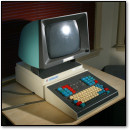The Music Computers Make: Impenetrable Noise and Silicon and Steel
April 12th, 2006 by Benj Edwards![]() For some computer lovers, the sounds that computers make is music to their ears. And by “sound,” I don’t mean 32-bit digitized audio coming from a Sound Blaster Audigy; I mean the actual mechanical whirrs, clanks, and cronks that emanate from computing hardware in action. They make you feel warm and fuzzy inside.
For some computer lovers, the sounds that computers make is music to their ears. And by “sound,” I don’t mean 32-bit digitized audio coming from a Sound Blaster Audigy; I mean the actual mechanical whirrs, clanks, and cronks that emanate from computing hardware in action. They make you feel warm and fuzzy inside.
It was this very love I had in mind when I set out to compose a “computer music” piece for a class I took at a local university back in Spring 2002. But I wasn’t exactly following the instructions (more on that later). The class focused on the history and composition of music generated by computers. Not pop music or anything like it, of course, but what I would typically call “highly inaccessible, elitist, please pull the stick from my ass” music. In particular, we learned about what proponents of the genre call “new music,” which pretty much means any music that has an unconventional structure, typically lacking vocals, instruments, rhythm or melody as we know them. The computer variety of this avant garde style arose from early attempts at generating music with computers in the 1950s and 60s, but lacking sufficient computational horsepower for a decent compositional AI at the time (and even now), composers could only squeeze abstruse sequences of notes from their machines. But (surprise!) some people thought it was cool because it was abstruse, and a new class of music elitists was born. They embraced the limitations of the medium and ran with them — straight into a wall. If you think you’d get a kick from the seemingly random bloops and bleeps generated from applying a complex algorithm to the DNA of sperm whales, then this music is definitely for you. Sure, it’s got a great “nerd factor,” but it’s hardly emotionally inspiring.
Don’t get me wrong; there is some excellent work out there in the field of computer music. It is important music in the grand scheme of things, and it can be highly enjoyable if you have the ear (and the patience) for it. The only thing I’m really cracking on is the attitude of the participants (particularly the “old school”), which is the exact opposite of the populist “anyone can pick up a guitar and play” attitude of Rock and Roll. The composers of the genre can easily come off as being equivalent to esoteric UNIX freaks (versus, say, common Joe-Schmoe Windows users). And yes, through my college course, I actually met quite a few of them. More recently, however, thanks to the retro video game music renaissance, computer music artists are starting to break from that stuffy mold, which is a wonderful relief. Video games save the day once again.
Enter Silicon and Steel
![]() So what better way to ruffle the feathers of an elitist computer music professor than to twist his own instructions for our final class project to my favor. The instructions given were to compose a musical piece that “could not exist without computers,” with an underlying assumption that the music would be generated by specially programmed software running on computers. Unwritten assumptions are the greatest source of loopholes in the world of rules. Thinking myself clever, I took the “computer music” title at face value, and decided to literally “play” and record the physical hardware elements of my vintage computers as if they were instruments. I used that method along with other computer-related “found sounds” both physical and electronic as the basis of my piece. Don’t expect any conventional melodic music, though. Silicon and Steel is essentially a glorified sound collage, but with more structure. Don’t bother telling me that it sucks, because from a popular music frame of reference, it most assuredly does. But if you temporarily free your mind of your preconceptions about music and think of Silicon and Steel as a “story told with sound,” then you might actually enjoy it.
So what better way to ruffle the feathers of an elitist computer music professor than to twist his own instructions for our final class project to my favor. The instructions given were to compose a musical piece that “could not exist without computers,” with an underlying assumption that the music would be generated by specially programmed software running on computers. Unwritten assumptions are the greatest source of loopholes in the world of rules. Thinking myself clever, I took the “computer music” title at face value, and decided to literally “play” and record the physical hardware elements of my vintage computers as if they were instruments. I used that method along with other computer-related “found sounds” both physical and electronic as the basis of my piece. Don’t expect any conventional melodic music, though. Silicon and Steel is essentially a glorified sound collage, but with more structure. Don’t bother telling me that it sucks, because from a popular music frame of reference, it most assuredly does. But if you temporarily free your mind of your preconceptions about music and think of Silicon and Steel as a “story told with sound,” then you might actually enjoy it.
Here are the original Silicon and Steel program notes from 2002, which are also included in the ZIP file of the entire piece at the bottom of this article:
Silicon and Steel tells the story of a fictional struggle between humans and computers after a major economic downturn that leaves humanity in confusion about the uses of technology and its role in their lives. The story pits the computers of the world against the Luddites — a term for people who protest the replacement of human labor with that of machines in our “real world.” In this story, the fictional Luddites’ fanatical ideology overtakes society and challenges the computer’s dominance in both the personal and business world.
This piece makes extensive use of the original and most natural source of computer music: computers themselves, and the sounds they and their peripherals make in day-to-day operation. Such sounds appearing in the piece were recorded from the composer’s personal vintage computer collection, from computers such as the Apple IIe, Atari 800, Atari 1040ST, Macintosh SE, Macintosh LCIII, a generic PC, and a variety of different disk drives and hard drives for these systems.
Also used in this piece were the sounds from an Atari 1027 impact printer, a Yamaha PN-101 dot matrix printer, a handheld electronic game, a Casio SK-1 sampling keyboard, a Yamaha keyboard for piano, an old computer program data cassette tape, and a “Signature Junior” 1960s-era portable reel-to-reel tape recorder. A few sounds were sampled from various real-world sources, but heavily manipulated with a PC. The smashing sounds you hear are courtesy of a hammer and a box full of old computer parts.
Voice synthesis is mostly courtesy of the Bell Labs text-to-speech web site, including those of the computer-sung songs in the piece. Another source of speech synthesis that makes an appearance was generated with a piece of software called “SAM” for the Atari 800 personal computer. The arrangement of “The Star-Spangled Banner” featured in “Victory” comes from Bank Street Music Writer for the Atari 800. The whole piece was put together using Acid Pro 3.0 and Cool Edit 96 for Windows 98 in April 2002.
Silicon and Steel Playlist:
1. Introduction (1:12)
2. Awakening (4:50)
3. Propaganda (2:24)
4. Battle (3:40)
5. Victory (2:54)Total Running Time: 15 minutes
Gimme The Audio, You Elitist Bastard
Download the full piece here: Silicon and Steel (13.2 MB – Includes five MP3s, M3U playlist, program notes).
[ If this piece is distributed, please maintain and do not edit the credits for this work, including the MP3 file names, ID3 tags in the MP3 files, and the explanatory text document. Thank you. It is with my faith in your honesty that this work is being released. Your help is greatly appreciated. ]
Excerpt: Listen to “a hundred computers booting” in
“Part 2: Awakening” of Silicon and Steel by clicking on
the gigantic shiny button below [Requires Flash].
A Final Word
Four years later, looking back, I find my piece both satisfying and lacking. There are many areas that I feel could be improved, but I did the best I could with the time I had and the recording technology at hand. If I had to do it again, I’d take out the computer narration and just let the sounds stand on their own. But I think it’s still worth a listen. I recommend lying down in bed with headphones, turning out the lights and closing your eyes while you immerse yourself in computer-flavored audio.
Oh — and the professor wasn’t really impressed with my cleverness. He gave me a “C.”






November 1st, 2006 at 3:04 pm
Go Kilroy!
Domo Arigato Mr. Roboto!
I like!…It’s on my mp3 player as we speak!